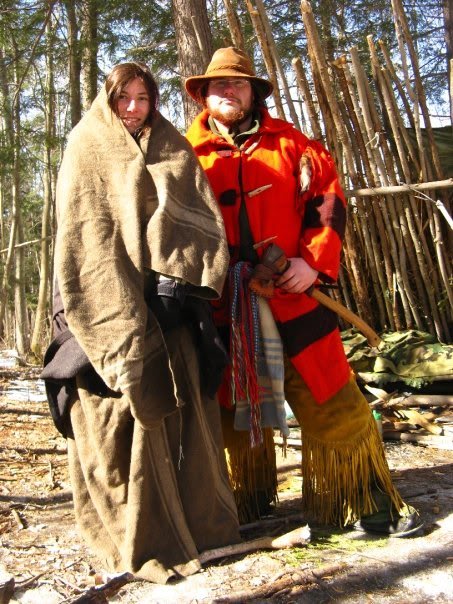I am not talking about when it is above freezing, or just a few degrees below. In Celsius, I am referring to around -20. At that stage,only two things will get you wet, your own sweat, and immersing yourself in water. The snow is dry as salt in the Sahara, the air is drier than a convection oven, and there is absolutely no reason for waterproof clothing.
That's right, I said it. No reason.
You see, at that temperature, if you put on anything, including gore-tex, Triple-Point or other Waterproof "Breathable" materials, or the classic pvc, Nylon or rubber footwear, you are actually worsening your condition.
As an example, if I was to wear four layers of woold socks, under a pair of moosehide moccasins (braintanned so that it remained breathable), along with two pairs of woold trousers, under perhaps a canvas bib, I would be more than comfortable from the waist down. On my upper extremities, two pairs of hand-cover (pair of wool gloves inside my big moosehide mittens), two hats (one snug and woolen, the other large and made of fur), I should be very warm. Include four layers of wool shirts/tunics/pullovers, made of light, but durable wool, I am truly set. The final piece would be a canvas parka shell, to cut the wind down.
This is what I often wear when it is in the temperatures where red squirrels run for cover, and hares don't come out for weeks. I am not warm in this clothing. Which is the point. You want to be cool, so that there is very little increase in sweat.
Layering is a pretty well-known subject, but we seem to forget what sort of fabric those layers should be. Research your region's most extreme of temperatures and weather. Then study, and experiment with variations in clothing. It works well, as I cannot tell you what you must wear. Do what feels comfortable.



That's right, I said it. No reason.
You see, at that temperature, if you put on anything, including gore-tex, Triple-Point or other Waterproof "Breathable" materials, or the classic pvc, Nylon or rubber footwear, you are actually worsening your condition.
As an example, if I was to wear four layers of woold socks, under a pair of moosehide moccasins (braintanned so that it remained breathable), along with two pairs of woold trousers, under perhaps a canvas bib, I would be more than comfortable from the waist down. On my upper extremities, two pairs of hand-cover (pair of wool gloves inside my big moosehide mittens), two hats (one snug and woolen, the other large and made of fur), I should be very warm. Include four layers of wool shirts/tunics/pullovers, made of light, but durable wool, I am truly set. The final piece would be a canvas parka shell, to cut the wind down.
This is what I often wear when it is in the temperatures where red squirrels run for cover, and hares don't come out for weeks. I am not warm in this clothing. Which is the point. You want to be cool, so that there is very little increase in sweat.
Layering is a pretty well-known subject, but we seem to forget what sort of fabric those layers should be. Research your region's most extreme of temperatures and weather. Then study, and experiment with variations in clothing. It works well, as I cannot tell you what you must wear. Do what feels comfortable.




